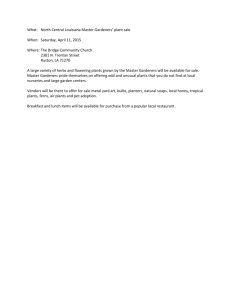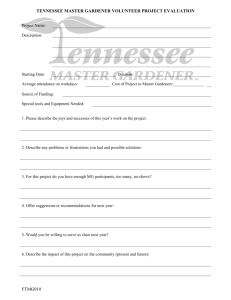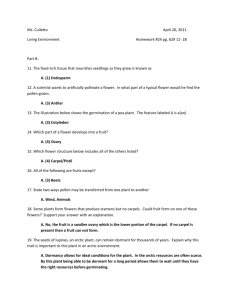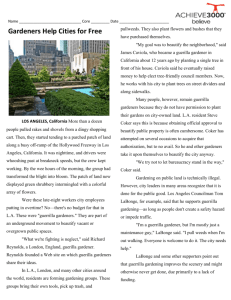2014 Seed Trials Report - University of Minnesota Extension
advertisement
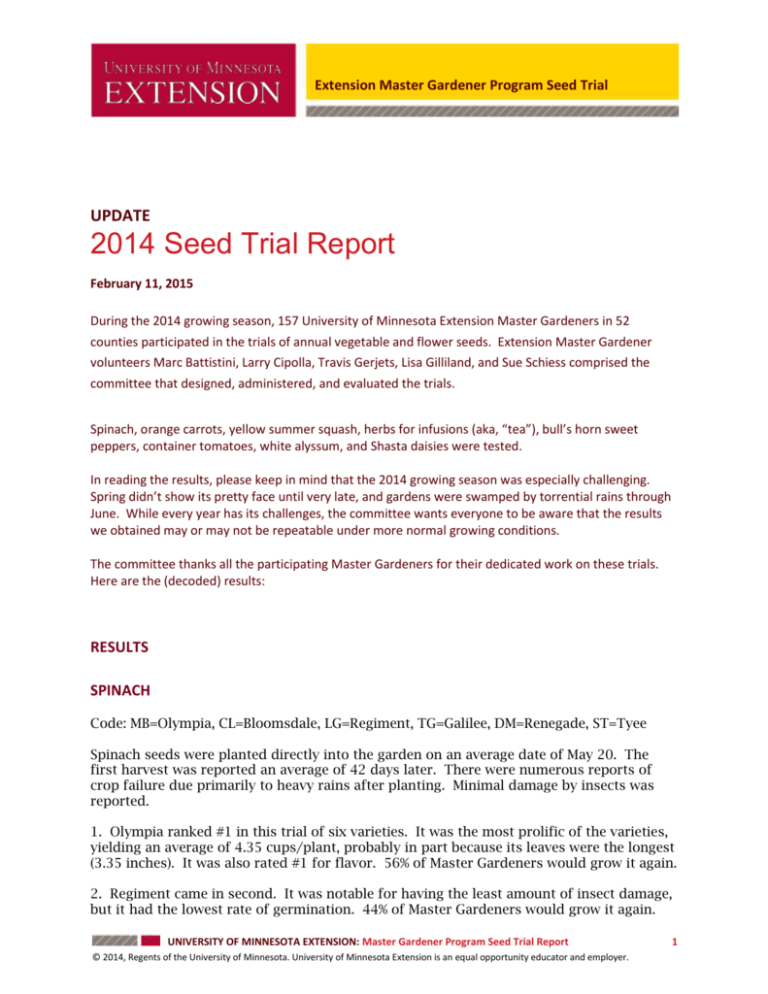
Extension Master Gardener Program Seed Trial UPDATE 2014 Seed Trial Report February 11, 2015 During the 2014 growing season, 157 University of Minnesota Extension Master Gardeners in 52 counties participated in the trials of annual vegetable and flower seeds. Extension Master Gardener volunteers Marc Battistini, Larry Cipolla, Travis Gerjets, Lisa Gilliland, and Sue Schiess comprised the committee that designed, administered, and evaluated the trials. Spinach, orange carrots, yellow summer squash, herbs for infusions (aka, “tea”), bull’s horn sweet peppers, container tomatoes, white alyssum, and Shasta daisies were tested. In reading the results, please keep in mind that the 2014 growing season was especially challenging. Spring didn’t show its pretty face until very late, and gardens were swamped by torrential rains through June. While every year has its challenges, the committee wants everyone to be aware that the results we obtained may or may not be repeatable under more normal growing conditions. The committee thanks all the participating Master Gardeners for their dedicated work on these trials. Here are the (decoded) results: RESULTS SPINACH Code: MB=Olympia, CL=Bloomsdale, LG=Regiment, TG=Galilee, DM=Renegade, ST=Tyee Spinach seeds were planted directly into the garden on an average date of May 20. The first harvest was reported an average of 42 days later. There were numerous reports of crop failure due primarily to heavy rains after planting. Minimal damage by insects was reported. 1. Olympia ranked #1 in this trial of six varieties. It was the most prolific of the varieties, yielding an average of 4.35 cups/plant, probably in part because its leaves were the longest (3.35 inches). It was also rated #1 for flavor. 56% of Master Gardeners would grow it again. 2. Regiment came in second. It was notable for having the least amount of insect damage, but it had the lowest rate of germination. 44% of Master Gardeners would grow it again. UNIVERSITY OF MINNESOTA EXTENSION: Master Gardener Program Seed Trial Report © 2014, Regents of the University of Minnesota. University of Minnesota Extension is an equal opportunity educator and employer. 1 3. Bloomsdale was third. It tied for second best in germination rate but otherwise was quite average. 37% of Master Gardeners would grow it again. 4. Tyee ranked fourth. It was the second most-productive variety, yielding an average of 3.8 cups/plant. Even though it came in fifth in germination rate, 56% of Master Gardeners would grow it again. 5. Renegade came in fifth. While it was among the least likely to bolt, it suffered the most damage from insects of all the varieties. Everything else about it was quite average. 44% of Master Gardeners would grow it again. 6. Galilee was a distant last. It had the lowest yield (2.09 cups/plant) and the shortest leaves (2.67”). It was judged the poorest in raw flavor, and it bolted on 85% of its growers. Only 4% of Master Gardeners would grow it again. ORANGE CARROTS Code: MB=Atlas, CL=Sugarsnax, LG=Touchon, TG=Red-Cored Chantenay, DM=Danvers HalfLong, ST=Nectar Carrot seeds were planted directly into deep, loose garden soil in rows that were 12” apart. Seedlings were thinned to 2” spacing as soon as they reached a small, edible size. They were sown on an average date of May 21, and harvested an average of 104 days later. Many reported crop failure primarily due to heavy rains after planting. There was minimal damage by insects. 1. Sugarsnax and Touchon tied for best carrot. Sugarsnax is a long (7.1” long), slender (1.2” across) carrot. It was voted #1 in both flavor and texture. It also had the best germination rate (53%) of all. 63% of Master Gardeners would grow Sugarsnax again. Touchon is average in size (4.6” long and 1.8” across), and it came in second in both flavor and texture. Its germination rate was average. 56% of Master Gardeners would grow it again. 3. Nectar came in third. In these trials it was average in every way. 59% of Master Gardeners would grow it again. 4. Danvers Half-Long placed fourth. It had the second best germination rate and the highest yield. Despite its name, it was of average length. 44.4% of Master Gardeners would plant it again. 5. Red-Cored Chantenay came in fifth overall. It was also fifth in germination rate and dead last in flavor. 37% of Master Gardeners would plant it again. 6. Atlas finished at the bottom of the pack. It is a short (2.6” long) fat (2” across) carrot. It had the lowest germination rate (23%) and the most insect damage (though it was still minimal). Only 26% of Master Gardeners would plant it again. YELLOW SUMMER SQUASH Code: MB=Early Prolific, CL=Multipik, LG=Cube of Butter, TG=Summer Daisey, DM=Saffron, ST=Seabring UNIVERSITY OF MINNESOTA EXTENSION: Master Gardener Program Seed Trial Report 2 Squash seeds were planted directly into the garden when all danger of frost had passed and the soil was warm. The average planting date was May 25. They were planted either three seeds to a hill, with hills spaced 3’ apart, or they were planted 6” apart in rows and later thinned to 18”. Fruit was harvested when relatively small so as to minimize the size of the internal seeds and the thickness of the skin. The average harvest date was July 20 (56 days after planting). Flavor was evaluated in raw fruit Results were so uniform among the varieties that few distinguishing characteristics were identifiable. Germination rates varied only between 66% and 71%, which is not statistically significant. The average size of fruit measured between 6.2” and 6.7” in length and between 2.0” and 2.3” across. All varieties experienced significant infection with powdery mildew, but fruit production was not affected. 28% of Master Gardeners reported problems with squash vine borers, and the incidence did not vary by variety. 1. Cube of Butter took first place (even though growers didn’t know its name ;-). 91% of Master Gardeners rated its flavor as either “very good” (50%) or “acceptable.” It took first place for texture. Production peaked in late July and averaged 20.5/plant. 77% of Master Gardeners would plant it again. 2. Multipik placed second. 86% of Master Gardeners rated its flavor as either “very good” (50%) or “acceptable.” Its texture was average for the trial. Its peak harvest was in late July, and it averaged 17.4 fruits/plant. 55% of Master Gardeners would plant it again. 3. Early Prolific earned third place. 86% of Master Gardeners rated its flavor a either “very good” (46%) or “acceptable.” Despite its name, it was ready for harvest no earlier than any of the other varieties in the trial. In every other way, it was “average” for this trial. 59% of Master Gardeners would plant it again. 4. Seabring came in fourth. It was average in every way for this trial. 59% of Master Gardeners would plant it again. 5. Summer Daisey was ranked fifth. Its only distinguishing characteristic is that the highest number of Master Gardeners (16%) rated its flavor as “poor.” Even so, 46% of Master Gardeners would grow it again. 6. Saffron took last place. The detailed trial data don’t reveal any particular weaknesses in this variety, but it clearly failed to excite anyone. Only 36% of Master Gardeners would grow it again. HERBS FOR INFUSIONS (AKA HERBAL TEAS) Code: LMB=Citronella Balm, LCL=Lemon Balm, CLG=Roman Chamomile, CTG=Common Chamomile, ADM=Snow Spike Hyssop, AST=Anise (Common) Hyssop All seeds were started indoors under lights and transplanted into the partial-shade garden when conditions were right (see below). Master Gardeners were given instructions for preparing both hot and cold herbal infusions and asked to prepare their “teas” in a consistent manner (either hot or cold) to facilitate comparison. It should be noted that all of these seeds struggled. Hyssop had the most difficult time and very poor germination rates. As a result, we recommend that gardeners purchase hyssop seedlings in the future rather than trying to start them from seed. UNIVERSITY OF MINNESOTA EXTENSION: Master Gardener Program Seed Trial Report 3 Balm seeds were sown indoors 6-8 weeks before average last frost date. They were transferred to the well-drained garden two weeks after the last frost and planted 12” apart. Chamomile seeds were sown indoors 8-10 weeks before the average frost-free date and transplanted into the partial shade garden, 8” apart, just before the last frost. Hyssop seeds were sown indoors 6-8 weeks before average last frost date. They were transferred to the well-drained garden two weeks after the last frost and planted 8” apart. 1. Citronella Balm took first place in these trials. 83% of Master Gardeners rated the tea flavor either “very good” (50%) or “acceptable.” The average height of the plant fell into the 9”-16” range. None flowered, though this may be an artifact of the unusually cool, wet growing season. 23% of Master Gardeners noticed insect damage to the leaves. 69% of Master Gardeners would grow it again. 2. Lemon Balm placed second. 73% of Master Gardeners rated the tea flavor either “very good” (62%) or “acceptable.” The average height was also in the 9”-11” range. One only plant bloomed, and its flower was purple. 15% of Master Gardeners reported insect damage to the leaves. 73% of Master Gardeners would grow it again. 3. Common Chamomile came in third. 62% of Master Gardeners rated the tea flavor as either “very good” (31%) or “acceptable.” The average height of the plant was over 16,” and it bloomed prolifically with white flowers. There was no insect damage to speak of. 54% of Master Gardeners would grow it again. 4. Anise (Common) Hyssop placed fourth. 85% of Master Gardeners judged its tea flavor to be either “very good” (69%) or “acceptable.” The average height was in the 9”-16” range, and they bloomed nicely with purple flowers. Almost a third of growers reported insect damage. 46% of Master Gardeners would grow it again. 5. In fifth place was Roman Chamomile. 44% of Master Gardeners judged its tea flavor to be either “very good” (22%) or “acceptable.” Its flowers were white. Other than that, it resembled Common Chamomile. 23% of Master Gardeners would grow it again. 6. Snow Spike Hyssop came in last. 82% of Master Gardeners judged its tea flavor to be either “very good” (46%) or “acceptable.” Its flowers were white, and it had very little insect damage. In other ways, it resembled Anise (Common) Hyssop. 35% of Master Gardeners would grow it again. BULL’S HORN SWEET PEPPERS Code: MB=Cubanelle, CL=Corno Giallo, LG=Goccia d’Oro, TG=Jimmy Nardello’s, DM=Italia, ST=Lombardo Evaluators were asked to start their seeds indoors in early to mid-March and to include one plant of each variety for the evaluations. All varieties reported good germination. Flavor ratings were acceptable to very good for all varieties. No disease or insect damage was reported for any variety. Depending on harvest times, evaluators reported a variety of colors that ranged from green to yellow, or green to red, or from yellow to red. Harvesting clustered around two periods: July 16-31, 28%, and after September 1st, 27%. Our pepper trials also suffered from the cold, wet spring. Many evaluators reported “stunted growth” through the first part of July. As a result, some of the data appeared contradictory depending on the county, the weather conditions, and whether the fruit were UNIVERSITY OF MINNESOTA EXTENSION: Master Gardener Program Seed Trial Report 4 harvested early or allowed to fully mature. Plants and yields did recover thanks to the warm, dry weather that we experienced through October. 1. Goccia d’Oro: This variety was rated number one overall, though it had the lowest yield of the tested varieties. It yielded only 8 fruit per plant. The size ranged from 4”-9”. Evaluators rated the color from green/yellow to green/red, and the flavor was very good/sweet. This variety was harvested about a week later than the other varieties (15 August), and 60% said they would grow it again. 2. Cubanelle : This variety was rated number two, but was mis-marked by our vendor. It was not Cubanelle (which is sweet), but probably Hungarian Wax (which is hot). The green/yellow fruit was 4”-9” and had acceptable flavor. It had the second highest yield at 17 fruit per plant, and 52% said they would grow it again. 3. Italia: Number three overall, the 4-9” green/red fruit had the second lowest yield of 10 per plant. 52% would grow this variety again. 4. Jimmy Nardello: Rated number four, this variety yielded 15 fruit per plant. The 4-9” green/red fruit were rated very good/sweet, and 60% said they would grow it again. 5. Corno Giallo: This variety had the lowest germination and averaged 15 green/yellow fruit, 4-9” in length. Only 37% would grow this variety again. 6. Lombardo: This variety was rated 6th however it had the earliest harvest (7 August) and had the highest yield per plant, 25. It produced narrow 4-9” green/yellow fruit. 48% would grow this variety again. PATIO CONTAINER TOMATOES Code: MB=Micro Tom, CL=Red Robin, LG= Tumblin Tom, TG=Tumbler, DM=New Big Dwarf, ST=Patio F Hybrid Evaluators were asked to start their seeds indoors in late March to mid-April and to include at least one viable plant for the seed trials. Containers were used by almost all evaluators, though a few planted the varieties in their regular garden. Although tomatoes can be cooked in many ways, we recommended that evaluators evaluate the flavor with raw fruit. This was not the best year for our tomato trials. Many evaluators noted poor growing conditions—cold, wet spring; very heavy rains in June (up to 12” in several counties). The warm and drier September and October helped to create a salvageable crop. All varieties reported good germination. All varieties produced red fruit. Most varieties produced acceptable yields, but none noted exceptional flavor. Harvesting clustered around two periods: July 16-31, 41%, and after August 15th, 37%. No insect damage was reported, however several reported Early or Late Blight. 1. Tumbling Tom: This variety was rated number one overall. It had the highest yield (57 per plant) and the flavor was rated acceptable to very good. The average size of the fruit was 1-4 ounces. The height of this variety was 12-20”. 58% said they would grow this variety again. 2. Tumbler: Rated second, this variety had the second highest yield (50 per plant). The flavor was acceptable to very good. Most fruit were 1-4 ounces and the height of the plant was at least 20” (or more). 58% said they would grow this variety again. UNIVERSITY OF MINNESOTA EXTENSION: Master Gardener Program Seed Trial Report 5 3. Red Robin: Number three overall with the third highest yield (38 per plant). The flavor of the one-ounce fruit was rated acceptable. The height of the plant was 10-18”. 54% said they would grow this variety again. 4. Patio F Hybrid: Rated fourth with the second lowest yield (16 fruit per plant). Flavor was acceptable to very good. The fruit were medium sized, 3-7 ounces, and the plant grew to 20” or more. 46% would grow this variety again. 5. New Big Dwarf: Rated fifth with the lowest yield at 9 per plant, this variety produced fruit that averaged 5-8 ounces on plants that grew 20” or more. 46% would grow this variety again. 6. Micro Tom: This was the lowest rated variety, which produced 1 ounce fruit on small plants, 8-10” high. The flavor was acceptable. Only 35% said they would grow this variety again, though several thought it would be a great “cute table-top” tomato. SHASTA DAISIES Code: MB=Silver Princess, CL=Snow Lady, LG=Crazy Daisy, TG=Silver Spoons, DM=White Breeze, ST=Alaska Seeds were started indoors under lights on the average date of April 4. They were transplanted into the sunny garden on the average date of June 2 and planted 12” apart. None of the varieties experienced significant insect or disease problems. While Shasta Daisies are grown as perennials in some climates, they more often serve as annuals in USDA Hardiness Zones 4a and below. Master Gardeners rated the flowering of each variety during the first week of July, August, and September. 1. First place goes to Snow Lady. The shortest of the varieties at 8.8” tall, it grew to be a robust 9.3” wide. Its flower diameter of 2.3” was about average. While its germination rate was below average, at 34%, it tied as first to flower. 47% of Master Gardeners would plant it again. 2. Silver Spoons took second place. In height (13.1”), width (11.9”), and flower diameter (2.0”) is was about average for the trial. Germination was also average. 47% of Master Gardeners would plant it again. 3. Crazy Daisy came in third. Its unique fringe-like petals make it quite distinctive, but it didn’t bloom very well during the trial. Its dimensions were 12.5” tall by 14” wide, the latter measurement making it the second widest. The diameter of the average flower was 2.6”. 41% of Master Gardeners would grow it again. 4. White Breeze placed fourth. It was the tallest (14.7”) of the varieties and consequently was rather floppy. Its width measured 9.6” and the diameter of its flower was 1.8”. At 48%, it had the second best germination rate, and it was the most abundant bloomer of all. 47% of Master Gardeners would grow it again. 5. Alaska finished in fifth place, though it had the best germination rate (49%), the largest flower (diameter of 3”), and was the widest plant (14.5”). It suffered by comparison to the others largely because it didn’t begin blooming until mid-September. 47% of Master Gardeners would grow it again. UNIVERSITY OF MINNESOTA EXTENSION: Master Gardener Program Seed Trial Report 6 6. Silver Princess came in last. Its germination rate was the second worst (34%), and while it bloomed best in July and early August, it never bloomed really well. Its dimensions (11.5” height, 10.2” width, 2.5” flower) did not distinguish it from the others. Only 35% of Master Gardeners would grow it again. WHITE ALYSSUM Code: MB=Wonderland White, CL=New Carpet of Snow, LG=Clear Crystal White, TG=Easter Bonnet White, DM=Snow Crystals, ST=Giga White Seeds were planted directly into ordinary garden soil on an average date of May 21. While pressed gently into the soil, they were not covered, as light is required for germination. As a result, many were washed away by the heavy June rains. A significant number of Master Gardeners reported a failed crop. No damage from insects or disease was reported. Due to the difficulty of counting tiny alyssum seeds when planting, Master Gardeners reported germination results in terms of excellent, average, poor, and none. They also rated the flowering of each variety during the first week of June, July, August, and September. 1. Snow Crystals took first place. While its height (6”), width (10.5”), and flower cluster diameter (.7”) were all about average, it was the most prolific bloomer. Though it was the second strongest bloomer the first week in June, it beat all the others in the following three months. 73% of Master Gardeners would plant it again. 2. New Carpet of Snow came in second and had the best germination rate. It was the largest of the alyssum plants, with a height of 6.3” and a width of 11.25”. The diameter of its flower cluster was a more average .75”, and it bloomed best from mid July through September. 64% of Master Gardeners would grow it again. 3. Clear Crystal White showed up in third place. It was about average in height (5.6”) and width (9.8”) and the diameter of its flower cluster (.73”). It bloomed best from mid July through September. 59% of Master Gardeners would grow it again. 4. Wonderland White came in fourth. It was the second shortest (4.7” tall) and the third narrowest (10” wide). Its flower cluster size was second smallest (.72”). It bloomed best in late July and early August. 5. Easter Bonnet White ran fifth in the trial, even though it had the largest flower clusters (.82”). It was the smallest plant, only 4.6” tall and 9.3” wide. It bloomed best from mid July on. Only 22.7% of Master Gardeners would grow it again. 6. Giga White finished in last place, probably because it had the smallest flower clusters (.7” diameter). In all other dimensions, it was average. It bloomed best from late July on. 32% of Master Gardeners would grow it again. The Seed Trials Coordinating Committee thanks every Master Gardener who participated in these trials. Your hard work makes these data helpful to home gardeners across the state of Minnesota! UNIVERSITY OF MINNESOTA EXTENSION: Master Gardener Program Seed Trial Report 7
